BA-5590/U Family
© Brooke Clarke,
N6GCE 2001 - 2020
Two "12" Volt batteries each with 7.5 AH capacity.
LiSO2 chemistry. Although there were some developmental
versions with a fuel gauge either the gauge did not work or the
cost adder was too high. The military is still purchasing
the BA-5590 without the fuel gauge. I wrote "12" Volts
because that's how the battery is commonly called, but it has two
strings of 5 LiSO2 cells and each cell is 3.0 Volts for
an actual output of 15 Volts.
The Army buys about 350,000
BA-5590 per year at a cost of about $100 each (includes
$30 each for disposal). There is a strong motivation to
find a replacement and fuel cells, micro turbines
and whatever else will supply the energy with equal or better
numbers for weight and dollars are being sought, but so far
there has been no winner.
The SO2 is pressurized to about 3 atmospheres (45
PSI) to make it a liquid so that it can act as the
electrolyte. There is a pressure relief valve that will
open around 350 PSI and stay open. When the battery
"vents" SO2 gas will escape and this is a hazardous
situation.
Note that because of it's very long shelf life the BA-5590
would be great to have in storage as an emergency backup
battery.
| Power Source |
Comment
|
NSN
|
Chemistry
|
Spec |
Spec Sheet |
Nom Volts |
Terminals |
Nom Wt |
Ht
|
Wd
|
Dpth
|
WH
|
| BA-5590B/U |
excellent
shelf life
|
see
below
|
Li-SO2 |
MIL-PRF-49471 |
MIL-PRF-49471/3 |
12 or 24
|
SC-C-179492 |
2.25 lbs, 1.03 kg |
5.0 in |
4.4 in |
2.45 in |
170
|
BA-5390
|
not common
|
6135-01-070-3865
|
MnO2
|
|
|
15 or 30
|
|
3.85 lb, 1.75 kg
|
"
|
"
|
"
|
|
Zinc-Air
BA-8140
|
12V only
non standard outline
|
6135-01-613-1464 |
Zn-Air |
|
|
12
|
|
|
|
|
|
400
|
BA-8180
|
for bat charging
non standard outline
|
6135-01-500-0572
|
Zn-Air |
|
|
12 or 24
|
|
6.2 lb, 2.7 kg
|
12.2
|
7.3
|
2.4
|
756
|
BA-5390A/U
|
Gas Gauge
SOC
|
6135-01-517-6060
6135-01-036-3495 |
Li-MnO2 |
|
|
|
|
|
|
|
|
|
Once activated the BA-81xx zinc-air batteries have a relativity
short run time and so are mainly being used to recharge the
BB-2590. Another reason for that is the BA-81xx batteries
are NOT in the 5590 form factor and so need some type of adapter
to power something.
In most cases this is done with an adapter that somehow looks
similar to a BA-5590 battery, but could be done using a custom "Y"
cable with a male plug for the ratio, a short cable to the BA-81xx
battery and a short cable with a female connector just like the
one on the radio. That way the "Y" cable could be inserted
between any existing cable and the radio. If a regular two
ended cable is installed between the radio and battery then any of
the radio functions that require use of the radio connector would
not be possible.
BA-5390A/U
This battery has two key features.
- The terminal voltage of a new battery is about 14.59V which
is lower than the nominal 16.8 V for the BB-2590. This
battery is safe for the Javilin (Wiki)
whereas the BB-2590 will burn it out.
- It also has a State Of Charge (Wiki: SOC)
indicator that works when the button is pressed. Four
green LEDs light on my battery with a date code of 1210A.

|
On the face opposite the SOC indicator
there is a discharge button, similar to the one on the
BA-5590A/U.
|
Battery
Supplies Ran Dangerously Low in Iraq - National Defense,
Sept 1, 2003 "The Marines were using 757 packs (each pack contains
four batteries) or 3,028 BA 5590s, per day."
BA-5590 NSNs
6135-01-036-3495
6135-01-070-3865
DEADLINED Batteries (Venting Problems)
6665-99-760-9742, manufactured by BALLARD Contract
DAAB07-90-C-C024
6665-99-760-9742, manufactured by CROMPTON ETERNACELL LTD
Contract DAAB07-91-C-4014
6135-01-036-3495, manufactured by SAFT AMERICA Contract
DAAB07-88-C-C045 & DAAB07-90-C-C020
6135-01-435-3097, manufactured by SAFT AMERICA Contract
DAAB07-90-C-C020
Secondary (Rechargeable)
Radios vs. Battery Use
It looks like modern radios use the two halfs of the
battery wired in series to provide 30 Volts. This way when
two batteries are used in parallel there are two benefits:
- The talk time is doubled
- One battery can be removed while the radio is operating and
replaced keeping the radio on line, this may be important for
digital coms.
|
Radio
|
Each Battery
|
Batteries Combined
|
Current Amp
|
|
PRC-119 SINCGARS
|
Parallel
|
n.a.
|
RT
1523E < 1.5 A
|
|
RF-3090 and PRC-117
|
Parallel
|
n.a.
|
|
|
PRC-104 HF
|
Series
|
|
Rx < 200 ma (180 ma)
Tx < 3.5 Amp (2.9 A)
|
|
LST-4
|
Series
|
n.a.
|
|
|
HST-5
|
Series
|
n.a.
|
|
|
PRC-113 dual band VHF/UHF
|
Series
|
Parallel
|
|
|
MXF-707 series
|
|
|
|
|
Motorola URC and LST
|
|
|
|
|
HST-4 series
|
|
|
|
Extra Top Contacts
The BA-5590 and earlier batteries in this family only had the
6-pin socket.
Extra
Top
Contacts
|
Photos
|
Function
|
Models |
0
|
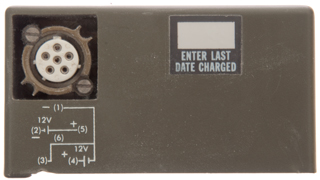
|
na
Note pins 1 & 3 tied together and sticker "Enter Last
Date Charged".
|
all BA-versions
early BB-390, BB-490, BB-590
|
2
|
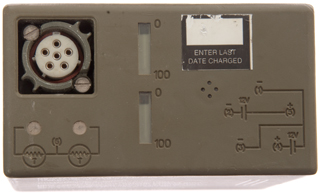 |
Thermistors for temperature (introduced
with BB-390 Ni-MH)
works with the center (6) pin.
BB-390 shown in photo at left.
Measure 9k7 and 9k7 to center (6) pin.
State Of Charge (SOC) indicators for both batteries.
|
BB-390
|
3
|
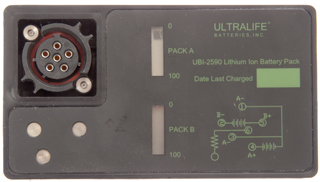 |
Charge Enable(SW) contact added from prior
batteries, works with the center (6) pin.
The Vehicle Mounted Battery Charger measures 7.4k from the
center pin to the enable contact.
The MRC-82A measures open circuit.
Temp contacts measure 411 and 411 Ohms to center (6) pin.
Note resistor shown between pin 6 and the SW top contact
for charge enable), but
nothing needed to charge, just may need to increase
voltage. I can charge one side
but not both in series with a 60 Volt power
supply. After a few minutes charging one
side I can not charge both in series.
33.6 VOC, 300 mA SC, voltage with battery connected
climbing from 30.2.
At a 3 amp charge it will take about 5 hours for each of
the 5 SOC bars.
The problem with charging both sides in series is that
when one side is full it opens the circuit and the other
side will not get any more change.
|
UBI-2590 (UBBL02)
|
8
|
 |
5 additional State Of Charge pins.
SMBus (Wiki)
Temp contacts measure short and short to center (6) pin.
The 5 top contacts just to the left of the SOC are top to
bottom:
Clock (pins 1 & 4 i.e. the A battery) (pin 1
data/clock gnd)
Data (Pins 1 & 4)
Charge Enable (same as SW)
Clock (pins 2 & 5 i.e. the B battery) (pin 2
data/clock gnd)
Data (pins 2 & 5)
Notice SOC showing full charge
The Ultralife UCH0057
Charger has a SBS ver 1.1 interface & a calibrate
function
|
UBI-2590 (UBBL10/B)
|
System Management Buss (SMB)
Scroll up to "8" see
the top of a Ultralife battery with the SMB contact pins, or
scroll down to the BrenTronics BT-2590
table for photos of them.
The TI EV2300
should allow investigating the data on the SMB pins.
I've got one and some cables, but need to make some sort of
test plug with pogo pins. Maybe when I get a round-TUIT.
A key question is: Can I just look at the data on the
1-4 set of pins and ignore the 2-5 pins? That would
eliminate the need for a voltage translation circuit since the
"ground" for the 1-4 data pins is about 16.8 Volts different
than for the 2-5 set of pins.
The Ultralife
UCH0057 charger includes SMB functions. But it
does NOT have a USB interface that would allow a computer to
see the real data, so for now the TI EV2300 seems to be the
most powerful way to look at and change SMB data, but that
requires a connector. I asked for a quote on the
connector but did not receive an answer.
BB-2590
The BB-2590 is made using 18650 cylindrical cells and as of
2016 is the most popular of the 5590 family of
batteries. Note the 18650 cell may be the highest volume
production Li-Ion battery, first because of it's use in laptop
computers and second, because of it's use in Tesla cars.
When you amortize the high cost of the BB-2590 over all the
recharge cycles and compare to the as delivered cost of the
primary BA-5590 the BB-2590 is a good deal.
The BB-3590 is functionally the same except it makes use of
"pillow" type Li-Poly cells. these offer higher
Wattt-hours per pound, since the pillow material is lighter
than metal and because there are no air gaps like with
cylindrical cells. See the inside
of a BB-3590 below.
BB-2590 Maintenance
Li-Ion charging involves two main phases, first constant
current bulk charging followed by constant voltage topping
up. A CC/CV lab DC power supply can easily do
this. Unlike lead acid batteries that can use a trickle
charge to maintain their charge Li-Ion batteries need a
different method of maintaining their charge. But how
that's done depends on the goal. (A pre-charge phase can
be added). Note the value of the constant voltage needs
to be precise and matched to the chemical soup of a particular
manufacturer and model battery.
If the goal is to have a fully charged battery ready for use in
the field then a charger that tops up the battery once a day
would be good. But that means that the battery voltage
will always be at it's highest value. The problem with
that is the life of a Li-Ion battery
is inversely proportional to the Voltage * Temperature.
This all relates to Coulomb Efficiency as described in the video -
Professor Jeff Dahn -
WIN Seminar Series. & a write-up based on this
video: Why
do lithium-ion batteries die? (long).
At 22:32 he
starts getting into the interesting stuff where the
charge/discharge rate (time) is normalized out.
Life = k /(Voltage * Temperature) [more time stored hot the
shorter the life)
So it would be good to keep the battery and charger in a cool
place.
If the goal is to store a new battery while waiting for use then
it should not be fully charged but rather at something like 30%
of full charge, i.e. to lower the terminal voltage thus
increasing life. Refrigerated storage would be far
superior to storage in a hot warehouse.
BB-2590 Cell Capacity
Typically use 4 cells per "12 Volt" battery where
each cell is made up of three each 18650 cells in
parallel. Total of 24 each 18650 cells.
So Watt Hours divided by 24 = WH per cell. Example: 207 WH
/ 24 = 8.625.
WH / 3.4V (discharged voltage) = Amp hours, Example 8.625 / 3.4
= 2.537 Ah or 2,537 mAh.
Example 2: 294 WH/2590 -> 12.25 WH/cell -> 3600 mAh /cell
As of Aug 2016 the highest realistic capacity cells are 3600
mAh. But there are plenty of cells labeled as 5000 mAh,
but the capacity is more like 1000 or less mAh.
See: BB-2590 Inside
Ultralife BB-2590 family:
See Extra Top Contacts
above for some Ultralife batteries.
Model
|
NSN
|
15V
AH
|
30V
AH
|
Energy
WH
|
15V
Amps/5 sec
|
30V
Amps/5 sec
|
SMBUS
|
Test Results
one side |
UBBL02
|
6140-01-553-3527
|
14.4
|
7.2
|
207
|
36
|
18
|
no
|
|
UBBL091
|
6140-01-620-8528
|
19.2
|
9.6
|
230
|
36
|
18
|
yes
|
|
UBBL10
|
6140-01-554-2347 |
14.4
|
7.2
|
207
|
12
|
6
|
yes |
6.66Ah, 100.2 Wh (1A load)
4.8Ah, 70.9Wh (2A, 14.4V)
6.6Ah, 96.6Wh (2A, 13.6V) |
UBBL13
|
6140-01-640-8702 |
17.4
|
8.7
|
250
|
36
|
18
|
yes
|
|
Note 1; Voltages are 12 and 24 rather than 15 and 30.
UBBL10/B (UK version of -10)
Ultralife
Patents
Dead Battery on one side
"seems like the 2 packs inside might be interconnected
somehow, as you know, I had some here that would only charge
on one side, other side flashing one bar no matter how long it
was on the charge. I put a load on the good side and
brought it down with a 1 amp light load ( did it several times
till it would not register any power on the filament.
Any way when I put them back on the charger, both sides
charged to full ca."
Mike M.
Bren-Tronics BTnnnnn family:
| Model |
NSN
|
15V
AH |
30V
AH |
Energy
WH |
15V
Amps/5 sec |
30V
Amps/5 sec |
SMBUS |
Test Results
one side
|
BT-70791BK
|
6140-01-490-4316 |
15.0
|
7.5
|
225 |
?
|
18
|
yes
|
6.75Ah,
102 Wh (1A load)1
5.97Ah, 89.6Wh (2A load) |
BT-70791CK
|
6140-01-490-4316
|
15.0
|
7.5
|
225
|
?
|
18
|
yes
|
6.87 Ah, 104.4 Wh (1A load)
6.17 Ah, 92.86Wh (2A load)
|
| BT-70791CG |
6140-01-490-4316
|
19.8
|
9.9
|
294
|
?
|
18
|
yes
|
|
Note 1: After discharging two Bren-Tronics batteries
and putting them on the CH0004 2-bay charger they both showed as
"90% Charged".
Pressing Discharge switched the 3 sides (one battery has a bad
side) to "Discharge".
The ending voltages were 15.something Volts. i.e. some
recovery from the 14.4 Volts used to end discharge.
|
|
|
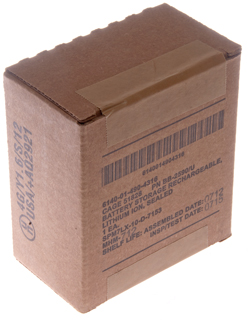
|
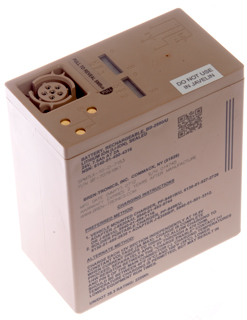
|
This battery manufactured July 2012
arrived Sep 2016,
ie. a little over 4 years old new in the box.
But there are no state of charge indicators on, it's
totally dead.
This may be one of a small number of BB-2590 battery
versions
require the Charge Enable Top contact in order to
charge.
But when placed in the BTC-70870-1
or PP-8498
SPC both of which
make use of three of the top contacts (including the
charge enable contact), but none of them would recognize
the battery so no attempt was made to charge it.
The warranty info says two years, so out of warranty.
The shelf life on these seems to be very short compared
to the BA-5590 which will probably sit on a shelf for 20
years while maintaining 80% of it's charge, but it's a
primary battery.
Still, I'm disappointed in the shelf life of a new
BB-2590 that's this short.
Just to the right of the socket is a "Pull To Reveal
SMBus" tab.
|
Bren-Tronics
Patents
5625273
Battery safety device, Bren-Tronics
Inc., Apr 29, 1997, 320/136, 320/DIG.13- protects from: excessive
heat generation, voltage reversal and short circuit
6242893
Lithium-ion and lithium polymer
battery recharging, Bren-Tronics,
Inc., Jun 5, 2001, 320/135, 320/136 - resistor used to sense
current not MOSFET (TI: BQ2058)
8961225
Flexible water-tight seal for a
movable component, Bren-Tronics
Inc., Feb 24, 2015, 439/587, 277/650, 285/349, 277/616, 285/351, 277/608, 277/603, 285/368, 277/609 - a stack of O-ring : Flat
washer : O-ring seals between connector and battery box.
Mathews
Associates
This came to me already nicely opened up.
Marked:
Battery, Rechargeable, BB-2590
Lithium (Li-Ion)
24 Volts, 6.8 AH @ 2 Amps
NSN: 6140-01-490-4316
Maf Date: 10/12 s,n-24790
It's made up of two strings of 18650 cells. Each string
is made up of 4 series batteries where each battery is 3 cells
in parallel. That's 12 cells per string, 24 cells
total. This is pretty much the standard for the
BB-2590.
The schematic is:
Batt-A
Batt-B
-(2)----|:-----|;-----|;-----|;-----(5) +
-(1)----|:-----|;-----|;-----|;-----(4)+
1
2
3 4
1
2
3 4
B
B B B
B
B B
B B B B
1
1 3 3
4
1 1
2 3 3 4
N
P N P
N
N P
N N P N
The following large pads appear on the PCB. I have
shown them above in what I think is the correct relationship
to the cell wiring.
B1N-A
B1P-A
B3N-A (Cut off black wire)
B3P-A (Cut off red wire) Note 1
B4N-A
B1N-B
B1P-B
B2N-B
B3N-B
B3P-B
B4N-B
Note 1: 0.06V in DMM Diode mode between B3P-A and B4N-A; -6 k
& 6k Ohms
Note 2: -OL(tone) & OL(no tone) between B1P-B and B2N-B;
-1.8M & 44.5 M Ohms
Fig 1. as received
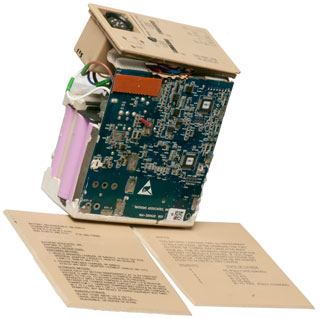
|
This is a modern BB-2590 that includes
the SMBus.
But it does not hold much charge 24 Volts @ 6.8 Ah is
only 163 Wh.
Considerably less than the above BB-2590 batteries.
You can see two large ICs on the right side of the PCB,
these are the charge controllers.
They have stickers covering the normal markings, so I
expect they are customized versions.
|
Fig 2. Battery Wiring
 |
Note that the large pads are where the battery tabs are
connected to the PCB and so are direct
connections to the cells. The A battery is in the
lower right and the B battery is to the left.
|
Fig 3 Charging
 |
Set HP bench power supply to 4.4 Volts and 200 mA and
checked each cell.
On the A side B1 seemed OK, but B2, B3 & B4 were all
below 1 volt, so connected between B2P and B4N
set the voltage to 11 and the current to 1.000
Amps. You can see in the photo the voltage is
about 4 not the 3 * 4.2 = 12.6 you would expect
from a charged battery. Letting it sit on charge
for now.
There are 3 out of the 4 cells on both the A and B sides
that are not taking a charge.
|
Pin Outs & Fuse
Primary Battery
Primary batteries use a plastic shell socket SC-C-179492
There are 3 socket wiring configurations:
- Single 6 Volt battery: 4 = +6V, 6 = -6V
- Dual 6 Volt battery: 4 = +6V, 6 = -6V & 3 = +6, 2 = -6V
- Dual 12 Volt battery: 4 = +12V, 1 = -12V & 5 = +12V, 2 =
-12V
Secondary Battery
Secondary batteries use a metal shell socket SC-C-179495.
Note that pin-3 is used only on secondary batteries as a charge
return. So, if a radio uses pin-1 as it's ground pin it does
not matter if it's a primary or secondary battery. But if a
charger uses pin 3 instead of pin 1 as the charging return then
the charger will not attempt to charge a primary battery.
But it seems this was some type of secret and later batteries no
longer followed the convention, but that does not mean it can not
came back.
There are 3 socket wiring configurations:
- single 6 Volt battery: 4 (wht w/red stripe) = +6V, 6 (blue)
= -6V
BB-507 (NSN-6140-01-034-3136) is a 6 Volt 4.5 AH Ni-Cad
battery used on the PSG-2 Tacfire Digital Message Device
- Dual 6 Volt battery: 4 (wht w/red stripe) = +6V, 6 (blue) =
-6V & 3 (White) = +6, 2 (Black) = -6V
- Dual 12 Volt battery: 4 (wht w/red stripe) = +12V, 1(Wht
w/Blk stripe) & 3 (Wht) = -12V & 5 (Red) = +12V, 2
(Black) = -12V
Battery Table
|
Battery
|
Chemistry
|
A
|
B
|
Other
|
AH series
|
Watt hr
|
Fuse1
|
Comment
|
BA-1590
|
Mercury
|
|
|
|
|
|
|
Obsolete
|
|
BA-5590
|
LiSO2
|
1- & 4+
|
2- & 5+
|
3 & 6 nc
|
7.5 AH
@ 0.5 A
|
210
|
2.25 A SB
|
main
primary
|
| BB-390 |
NiMH |
1,3- & 4+ |
2- & 5+ |
6 termistor4
cntr tap |
3.6 AH 2
@ 0.72 A |
100
|
none |
main
secondary
|
BB-390B
|
NiMH |
1,3-
& 4+ |
2-
& 5+ |
6
termistor4 cntr tap |
4.9 AH
@ 0.72 A
|
118
|
none |
|
| BB-490 |
SLA |
1,3- & 4+ |
2- & 5+ |
6 nc |
1.8 AH
@ 0.35 A
|
43
|
none |
obsolete
|
|
BB-590
|
NiCad
|
1- & 3,4+
|
2- & 5+
|
6 nc
|
2.2 AH
@ 0.5 A
|
62
|
none
|
|
|
BA-7590
|
LiMnO2
|
1- & 4+
|
2- & 5+
|
33 & 6 nc
|
12 AH
@ 2A
|
288
|
2 A max
|
|
|
BA-5390
|
LiMnO2
|
1- & 4+
|
2- & 5+
|
3 & 6 nc
|
11.3 AH
@ 2 A
|
271
|
2 A max
|
|
|
BB-25906
|
LiIon5
|
1- & 4+ |
2- & 5+
|
3 & 6 nc
|
6.2 AH
@ 0.4 A
|
174
|
? |
24 cells
|
BB-557
|
NiCad
|
1,3- & 4+
|
2- & 5+
|
6 nc
|
0.45 AH
@ 0.5 A
|
13
|
?
|
~1/2 size
|
Note1 Some radios, like the
PRC-104, pull more that 2.25 Amps, so a single BA-5590 will not
work becasue of it's internal fuse, maybe that's why the battery
box holds 2 each BA-5590 batteries.. Note that the BB-390
and BB-590 do not have a fuse to limit the current.
Note 2 When the BB-390 is used in the PRC-104,
or other radios that pull a lot of current, the AH capacity will
be much lower than the stated capacity at a lower current.
Note3 Pin 3 is jumpered to pin 1 when the
battery is rechargable. This way the radio knows NOT to try
and charge a primary battery that would explode.
Note4 The BB-390 has two thermistors that are
used to sense the temperature of the A and B sides. Socket
pin 6 (center) is that common connection for these and there are 2
other connections that are not part of the socket, but rather are
on the top surface of the battery. The BB-390 also has 2 gas
gauges. There are different version letters and each has
more watt hour capacity. The "B" version may also have an
improved gas gauge.
Note5 The charging profile for a Li-Ion
battery is very different from a Ni-Cad or Ni-MH battery and so a
different charger is needed. There may be an upgrade for the
PP-8444 to handle Li-Ion batteries. There also might be some
special socket wiring to identify the Li-Ion chemistry to the
charger would know which profile to use. In the future I
think (today is 27 Aug 2004) there will be a digital bus between
the battery and load/charger as is now used for laptop Li-Ion
batteries.
Note6 Video1, video2 showing BA-2590
catch fire when shot by an M 16 and all the cells catch fire due
to overheating. Would make a good incendiary device.
Also shows the 18650 cylindrical Li-Ion cell spouting fire when
squeezed or punctured.
WARNING - the fully charged
voltage of the
BB-2590
is 16.4 volts per side or 32.8 volts for a series
connection. A fresh BA-5590 is right on 15 volts per side
or 30 volts for a series connection. This higher voltage
can cause problems for some equipment that was not designed to
take it such as the Javlin system and the
SINCGARS
RT-1523A & RT-1523D (EGTN version). Li-Ion
batteries have a very low internal resistance and so this
voltage does not drop when a load is applied like would happen
with alkaline cells and the equipment must be able to take the
extra high input voltage.
What is a 12 Volt Battery?
Many radios are made to operate from the common
automotive "12 Volt" electrical system. Some voltages found
are:
- 14.8 Volts when engine is running and vehicle battery is
being charged
- 13.6 Volts when battery is charged but not being charged or
drained
- 12.0 Volts minimum discharge voltage to allow full recharge
- 10.0 Volts minimum usefull voltage if willing to kill
battery to get something from it
So if a radio, or other electrical equipment, is going to work
with the automotive electrical system it needs to be able to
accomodate a voltage range of 10 to 15 volts. For military
vehicles that use "24 Volt" systems the range would be 20 to 30
Volts.
If a battery manufacturer was going to make a battery for a
radio that was designed to work on a "12 Volt" automotive system
they could make the terminal voltage very close to 12 Volts, but
since the radio can work with 15 Volts a much better choice
would be to make a 15 Volt battery. This is the Case with
the BA-5590. They could have used 4 each 3 Volt LiSO2
cells for 12.0 Volts, but used 5 each 3 Volt cells for 15.0
Volts. Some after market battery manufacturers don't seem
to understand this and actually made a 12.0 Volt battery, I
don't think it was used much.
Note that for radios where the battery voltage is used directly
for audio or R.F. power amplifiers the power available is
proportional to the square of the battery voltage. So at
15 Volts the power is 2.25 more than at 10 Volts.
How to Compare the capacity of different
Batteries?
Amp Hours
When comparing batteries with the same terminal voltage the
"Ampere Hour" rating is a convient tool. Amp Hours (AH) makes it
easy to convert from the radios current draw into operation
time. For example a battery rated at 7.5 AH with a terminal
voltage of 30 Volts will power a radio that draws 1 Amp for 7.5
Hours. If the battery is made up of a single series string
of cells then the AH rating of the string is the same as the AH
rating of one of the cells.
Capacity depends on load current
That example is not quite
true. Most batteries are rated at C/20 (lead acid) or C/10
(most rechargeable types). So a lead acid battery rated
for 7.5 AH will supply 375 ma for 20 hours. Or a Ni-MH
battery rated 7.5 AH will supply 750 ma for 10 hours. Note
that the capacity decreases if the current is increased so a
Ni-MH battery rated 7.5 AH loaded at 1.5 amps may only run for 3
hours, not the 5 hours the AH rating might suggest. This
works the other way, if the load is less than the C/10 rate the
capacity will be greater than the rated value. This is why
battery makers publish discharge curves.
Watt Hours
Now suppose that you want to compare batteries that have different
terminal voltages. For example you could use 10 AA cells in
my 68BA battery
adapter or 12 AA cells. They are both in a series string so
both have 1.3 AH capacity. But since the voltages are
different you can not say that the radio will have the same talk
time. One way to look at this is to use Watt Hours (W =
Volts * Amps).
The 10 AA battery has a terminal voltage of 12.0 Volts (NMH cells)
and the 12 AA battery has a terminal voltage of 14.4 Volts.
So the 10 cell battery has 15.6 WH and the 12 cell has 18.7
WH. Since the radio will stop working when the battery
voltage goes below some threshold you can see that the higher
voltage battery will last longer, all other things being equal.
DC-DC Converters
A DC-DC converter (Switching Mode Power Supply) can be thought of
as a transformer for DC. The power delivered to the input
must be slightly greater than the power delivered to the load
(Efficiency is not 100%). So if the output voltage is twice
the input voltage the input current will be a little more than
twice the load current.
When a battery feeds a load using a DC-DC converter the Watt Hour
method can be applied to the battery that drives the converter and
the efficiency applied to show the output. For example a
DC-DC converter might run from 16 each 1.5 Volt cells and supply
13.6 Volts.
If they were Alkaline "C" cells then they would contain 8.35 AH
per cell so the Watt Hours = 1.5 Volts * 16 cells * 8.35 AH =
about 200.4 WH. If the efficiency of the DC-DC converter is
90% then the capacity in terms of the output would be about 180.2
WH. This is more than the capacity of the BA-5590.
When a radio uses an internal DC-DC converter the load on the
battery is different than a conventinal load. In this case
as the battery voltage goes down the current draw goes up,
not down like with a resistive load. Since the life of
a given battery in watt hours increases as the current drawn
decreases, higher voltage batteries will last longer than lower
voltage batteries with the same watt hour rating.
Battery Adapter
27 Aug 2004 - waiting for the sockets to arrive so they
can be designed into the bracket that goes into the adapter.
The Lithium Polymer batteries need to have a
protection circuit to pervent over voltage during charge or under
voltage during discharge. This needs to be done for each
cell for best results, rather than on the whole stack of
cells. Many of the ICs used for this prupose are designed to
be linked with a microcontroller that has a number of functions,
such as:
- Cell balancing during charge. If one cel's voltage
increases and causes the total stack current to decreas, then
the total watt hours of charge put into the stak will be less
than what it could hold. By controling the voltage drop
on each cell during charge it's possible to optimize the
amount of charge put in the battery.
- Over Voltage protection during charge.
- Under voltage protection during discharge.
- Temperature monitoring of battery both for safety shutdown
and capacity prediction.
- Smart Gas Gauge. This means much more than just
coulomb counting during charge and discharge. Although the
battery starts out with design information on it's capacity,
the smart gas gauge remembers the actual capacity of the
battery and also can predict capacity under different
conditions of load current and temperature. This is
communicated to the load as a percentage of actual or design
capacity. A common feature on modern laptop computers.
The smart gas gauge also communicates with a smart charger
telling the charger the profile needed to charge the
battery. Li-Ion type batteries can be charged at the 1 C
rate, but that rate will be different for each new cell type
and so for the fastest safe charge the current limit needs to
be different. This also may change for a given battery
serial number over it's life.
There is a standardized 2-wire battery communication bus used
for the above battery to charger/load communications.
This buss is also used by the manufacturer to put the smart
gas gauge in the sleep mode so that no battery power will be
wasted during storage or shipping. The battery also has
the manufacturers name, model and serial number information
stored inside and so can be tracked in logistic systems , or
maybe future radios.
The Smart Battery
System (SBS) - defines the digital bus used for these
battery specific communications. The following standards
are more general.
The System Management Bus
(SMB) - is a general Intel based bus for computer internal low
speed communications, and is used for battery management.
The
Advanced Configuration and
Power Interface (ACPI) - ACPI establishes
industry-standard interfaces for OS-directed configuration
and power management on laptops, desktops, and servers.
The current SINCGARS radios
have a coulomb counting gas gauge built into the radio designed
to work with the BA-5590, but it will not be correct if any
other battery is used. Note that the BB-390 is now up to
the BB-390B version that has more capacity than the plain
BB-390, so a battery type menu option in the radio will not
work. But what might work is a Watt Hour capacity that's a
user input. That would handle both the variatin in battery
capacity and would handle the case of a battery being removed
and later reinstalled (if the battery was marked with it's
remaining capacity).
What's needed is a way for primary batteries to tell the radio
their capacity in a way that adds very little cost, i.e. it does
not make economic sense to put gas gauges or SBS chips in
primary batteries and then throw them away. Although a
reusable SBS type module might make sense for primary
batteries. Rechargeable batteries need to have the SBS
interface for both the radio and the charger. I've heard
that in volume the cost of a gas guage may come down enugh that
it would work on a BA-5590 type battery.
Example: A BB-2590X s/n 1 is being used and is pulled from
the radio and put on a charger. BB-2590X s/n 2 is put on
the radio and used for some time. Now BB-2590X is put back
into the radio. When each battery is installed and
thereafter the remaining talk time will be known.
July 2004 - The AA version of the adapter is passing
load testing and a pair of them powers the PRC-104.
It appears possible to also use Lithium polymer cells for about
twice the watt hours of the "AA" battery version. Gel cells
are another possible energy source. The sheet metal shop is
working on the box quote.
12 June 04 - It turns out that the "C" cell load testing on 11 Sep
2003 was misleading since the battery holder springs got very hot
and melted the plastic holder. Some measurements and
calculations show that the steel springs used to hold the
individual batteries have way too much resistance for high current
use. Working on lower resistance contact method.
11 Sep 2003 - Load testing of 4.5 AH "C" cells shows that with a 3
Amp current the terminal voltage drops from 10.5 Volt to 8.5 Volts
for freshly charged batteries. This means that a passive
battery adapter holding 16 each "C" cells can only put out 17
Volts with a 3 Amp load (a PRC-104 transmitting is a 3 Amp
load). So a Switching Mode Power Supply (SMPS) is needed to
boost the output up to 24 Volts. Note the the output power
is amps times volts, so a 30 Volt @ 3 amp supply is a 90 Watt
source, but a 24 Volt @ 3 Amp source is a 72 Watt source.
The 8 4.5 AH "C" cells ran for 5 hours with a load that was 200 ma
for 9 minutes then 3 Amps for 1 minute, repeated until the battery
voltage for the 8 cells dropped below 8.0 Volts. The battery
supplied 14.4 AH. The discharge curve was flat, meaning that
if the SMPS can use voltages slightly below 8.0 (maybe 0.9
Volts/cell * 8 cells = 7.2 V.) more energy can be taken from the
"C" cells giving a longer run time.
This version of the battery adapter was being designed to use 16
"C" cells and supply 24 Volts at up to 3 amps. 8 cells have
a total resistance of about 0.7 Ohms, but some of this may be due
to a poor quality plastic battery holder used for the test.
Battery Eliminator
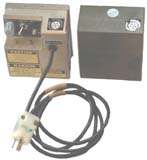
This battery eliminator runs from the 115 VAC line and fits into
the
USM-481 suitcase packaged crypto
cable test set.
Has on-off switch, fuse and pilot light.
The power cord comes out the large face and so it would not work
in most radio type battery boxes. It would work for radios
that only use a single BA-5590, like maybe a
SINCGARS.
The
5590BA Battery Adapter can be used
as a connector to make your own battery eliminator.
Connection is easy since there are Power Pole connectors on the
inside of the 5590BA.
Manufacturers
Eagle-Picher - Energy
Products Corp. - BA-5590/U
-
http://www.epi-tech.com/,
click on: departments, scroll down to EPEnergy Products,
applications then you will see: Lithium Sulfur Dioxide: Cells
& Batteries, Lithium Manganese Dioxide: Cells
& Batteries, Lithium Ion Cells
|
Part Number
|
Designation
|
Cell Dimensions (mm)
|
Capacity
|
Voltage
|
Wt (gr)
|
|
LS-3355
|
D
|
33.0 dia x 55.0
|
7.2Ah
|
3
|
78
|
US Patent
4,610,370 - Pressure release vent
The LS-3355 "D" cell used in the BA-5590 is rated up to 4
Amps.
The BA-5590/U is also rated at 4.0 Amps.
McDowell Research Corporation -
makes a number of rechargable versions of the BA-5590
Battery
Lists -
MRC-390 - Nickel Metal-Hydride 12/24 V Rechargable
battery (BB-390)
MRC-490(V1)
- Sealed Lead-Acid Rechargable 12/24 V Battery (BB-490)
MRC-590/U
Nickel Cadmium Rechargable 12/24 V Battery (BB-590)
MRC-690 -
Sealed Lead-Acid Rechargable 14/28 V Battery (BB-690)
MRC-2590 -
Lithium Ion Rechargable14.4/28.4 V BATTERY
Power Conversion Inc. - 1995
contract -> Hawker
Powersource,
Inc. only lead acid batteries on their web site
Saft Batteries - (EAC
Saft web page ) - Li-SO2 : LiSO2, G
cell series - BA-5590
2 * 7.6 AH @ House
of Batteries $104 each commercial, $133 military /U
version -
Cell type
construction
Open
Nominal Voltage
Rated Maximum
Weight
Safety
NATO
circuit
voltage
cut-off capacity
dimensions
features
stock
voltage number
BA 5590/U 5 LO 26 SX-2 14.7
V 14.0
V 10.0
V 7.5 Ah
127x111.8x62 1020 g 2.25 A
fuse 6135-01-036-3495
(2 sets
of
29.5 V
28.0 V 20.0
V 15.0
Ah mm
terminals)
Ultralife Batteries,
Inc. - (Battery
Power Ad) - Special/Military
- BB-X590
Li-Ion rechargable -
UBI-2590
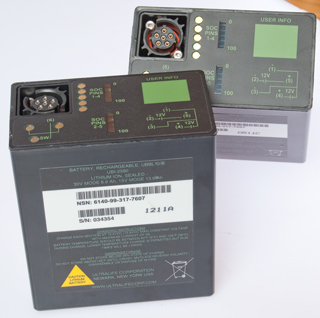
Electrochem Battery
Division (formerly Battery Engineering Inc. (BEI)) -
Golden Season -
Singapore
Replacement Versions
BB-390
BB-390 is the Ni-MH version; Most likely 10 cells
with an open circuit voltage of 13.6 when freshly charged per
battery. It's rated for 4.8 AH so at 13.6 Volts per side you have
27.2 V * 4.8 AH = 130 Watt Hours. The maximum voltage for
two sides connected is series is 32.8 Volts. The final
voltage for discharge testing is 10 Volts per side. Has a
State Of Charge indicator built-in. Also has temperature
sensing thermistors so charger can see temp rise when Ni-MH cells
get hot at end of charge. Note the thermistors are not
needed on the Ni-Cad BB-590 becasue that battery chemistry does
not get hot like the Ni-MH chemistry.
I have heard that the BB-390 uses AA size cells with two strings
of 10 each making up one battery (20 AA per battery) or 40 Ah
total.
Discharge Rate Table
Amps
|
Volts
|
0.01
|
26.27
|
0.1
|
26.25
|
0.5
|
26.04
|
1
|
25.76
|
1.5
|
25.47
|
2.0
|
25.18
|
2.5
|
24.8
|
3.0
|
24.4
|
3.5
|
24.2
|
4.0
|
23.8
|
4.5
|
23.4
|
5.0
|
23.01
|
Note
1 - I stopped at 5 Amps even though the output
voltage still had not decreased to 20.0 Volts where most radios
cut off. 5 amps at 23 Volts is a 115 Watt load and I'm not
comfortable pulling more power than that. Next is a run
time test using the ½ PRC-104 cycle. Run time was 12.4
hours not that much more than the 5590BA at 8 hours.
BB-490
BB-490/U
is a lead acid version. Although these are available on the
surplus market it's almost certain that one or more cells are
dead.
BB-590
BB-590 is the NiCad version Rated at 2.2 AH. Final
voltage is 20 Volts for the two sides connected in series.
Uses 20 each CsD size cells so the capacity is
27.2 Volts * 2.2 AH = 59.8 Watt Hours.
The actual Watt Hours for the BB-390 and BB-590 will exceed the
specification at room temperature and when the number of charge -
discharge cycles is low. They should meet the specification
under all specification conditions.
9 May 2004 - WARNING
I was charging a BB-590 according
to the instructions on the cover (actually I was at 350 ma
instead of 360 ma) and after less than an hour the battery
exploded! The cover (that has the instructions) blew off
and landed about 10 feet from the battery! My left ear was
ringing for awhile. The battery was not hot immediately
after this. There is an outward "dent" in the cover and
there is a black area between two of the cells. The fifth
cell up from negative terminal 2 is shorted. NSN
6140-01-063-3918, DAAB07-84-D-H309, mfr date 0885
It's my understanding from Saft that when a Ni-Cad is over
charged it generates oxygen and hydrogen. Normally these
gasses are adsorbed by the negative plate, but in an old battery
the gases might vent and then any spark would cause an
explosion.
Radio Recon
BC-778(A)
- battery adapter for BA-5590 that uses 16 each CR123 photo
batteries for each 12 V section
Note: 16 * 3.0 V = 48 V, so some series parallel connection, not
all in series.
Each side has two strings of 4 cells (12.0 Volts) connected in
parallel. This was a mistake, i.e. "12.0 V" (the dead
voltage of a BA-5590) they should have used 5 cells in
each series string for 15.0 V, but then there may not have been
enough volume?
Electric Fuel - developing
a zinc-air
version - see above
Pem Fuel Cell System Replacement
for BA-5590 Battery - proposal
Micro
Turbine Engines for Soldier Power -
MIT - Micro
Engines -
Tectonica Australia -
miniature diesel generator "Generette"
UltraCell - Menthonol
to Hydrogen Fuel Cell
LG
chemicals -
'Biofuel
Cell' -
BB-2590 Inside
There are a number of versions made by different companies.
The number of extra top contacts
may be 3 or 8.
Some photos showing the inside of a Bren-tronics
24V 6,2 Amp Hour at 2A load BB-2590 battery.
There is group of 10 TO-220 packages which are IRF
4905 HexFets attached to a couple of heat sinks.
The highest pin count chip (28 pins) is the Powersmart - PS401
Accuron single chip battery manager.
Powersmart seems to be out of business, but Microchip offers the PS501
which seems to be very similar.
The battery management chip was made by Microchip (it has their
logo) and the PS401 was their first generation battery
management chip. The PS501 is a similar chip aimed at
Ni-xx chemistry battery packs.
Maybe Microchip quit making these chips because TI it very big
in this business?
BB-3590 Inside
The BB-3590 uses Li-poly "pillow" cells instead of the Li-Ion
18650 cylindrical cells used in the BB-2590. This results
in a higher capacity and better energy density battery since the
pillows are sized for the battery and there's no gaps like with
the cylindrical cells.
Markings:
Battery Rechargeable BB-3590/U with SMBus
Lithium Ion (Li-Ion) Sealed, 29.6 V, 8 AH at 2A, 239 Wh
P/n: 800002-0801P0004 NSN: 6140-01-571-5794
DOW Kokam. CAGEL SYNF7
Made using 8 each Li-poly pillow type
cells.
The battery between pins 2 & 5 may be OK, but there is no
connection between pins 1 & 4 and a high current carrying
wire is open.
Maybe there was a short in the load applied to the battery or
maybe the center cell failed (it tests bad) and the other cells
test the same (probably OK). A lot of black and it smells.
BB-3590/U

|
|
|
|
M-25 Fuel Cell
BA-8180 Zinc Air
Zinc Air batteries (Wiki)
have been around a long time. Typically used in
hearing aids and as a replacement of Mercury button cells.
BA-8180/U is a primary battery (non rechargeable) configured as
two seperate "12 Volt" batteries, like the BA-5590. That
way the equipment can be wired to use the cells in parallel (12
Volts) or series (24 Volts). It's capacity is 800
Watt-hours. Note the the current BB-2590 Lithium batteries
are around 300 WH capacity, so this holds almost 3 times more
energy.
J-6686 MBITREI Adapter
NSN: 5940-01-517-3990
This is a two part adapter. The main unit connects to
the connector on the BA-8180 and has a body that attaches tot
he MBITR (PRC-148).
There is also an adapter cable that plugs into any of the
BA-5590 series batteries and has the same connector as the
BA-8180. That allows using the radio adapter with any of
the BA-5590 family radios.
BA-8180 Connector: Amp 211398-2 with positions 1, 2, 6
& 7 populated with sockets and the other positions empty.
BA-8180
|
BA-5590
|
Connection
|
MBITR
|
Description
|
1
|
5
|
+12V-B |
|
Center Ring
|
2
|
4
|
+12V-A
|
|
Center Ring |
6
|
1
|
-12V-A |
1
|
Gnd Lug
|
7
|
2
|
-12V-B |
2
|
Gnd Lug
|
See the RF-5800 Batteries
section for theThales 12050-2005-01 Battery Holder for a
very similar part.
BA-8180 pins 6 & 7 are hard wired to the MBITR ground
lugs.
BA-8180 pins 1 & 2 are routed through diodes to the outer
center terminals (center ring).
There is no connection to the very center terminal.
The connector on the main MBITR coiled cable: Amp MP 211400-1
Photos
Fig 1

|
Fig 2 Amp 211398-2 Socket to Battaxx
BA-5590 Plug
 |
Fig 3 Amp 211400-1 to Radio
 |
Fig 4
 |
J-6687 Satcom HF Adapter
This came new in the box. There was no manual, only the
same single sheet sales flyer that came with the above J-6686
MBITR adapter.
This shows the BA-8180/U (800 WH) and BA-8140/U (400 WH)
batteries on one side and adapters on the other side.
The web page for electric-fuel.com
shows they quit making all the products on the flyer around
2019.
This seems to be a major design fail in that the whole point
of the Zinc Air battery is high energy density (WH/lb).
To glue a couple of lead acid batteries inside the adapter
seems very strange. I thought the Army (all military?)
had banned products with internal batteries, especially ones
that were a secret, like this one.
I can think of a couple of possible reasons they did this:
1. The current output of the Zinc Air batteries was not high
enough and the lead acid Gell Cell battery could supply more
current. I have used that trick when a bench top power
supply did not have enough current capability. By
putting a lead acid battery in parallel you can drive a much
larger load for a short amount of time. The top of the
adapter is marked "BA-8180/U". The BA-8140 is not
mentioned. That may be a hint that the BA-8140 is
lacking the current drive some of these radios need.
2. The adapter only has a single replica battery
socket. The other socket location is a cylindrical
depression that allows the second plug on the bottom of the
radio to not hit the adapter. It might be possible to
"hot swap" a single BA-5590 family battery while the radio is
operational since either of them would keep the radio
operating. I have not seen this mentioned in a manual,
but it's possible to do. Having the two 12 V internal
Gel Cell batteries would allow "hot swapping" the
BA-8180/U.
Note that in either case above when the BA-8180/U is
connected to the J-6687 adapter it charges the internal
batteries. The top of the adapter is marked:
"Disconnect adapter from battery when not in use to conserve
battery power. I'm sure that the load is the internal
Gel Cell batteries. Otherwise there would be no need to
say that.
The above table of how the BA-8180/U is wired to the BA-5590
family socket is the same as for the above adapter.
State of Charge
It is difficult to determine the State of Charge for
batteries that have the LiSO2 chemistry. This is because the
voltage vs. SOC curve is very flat as a result of the internal
resistance being low and constant vs. SOC. Conventional SOC
meters that measure the loaded terminal voltage do not work on
LiSO2 batteries.
The Chemtronics LS (Lithium diSulfide) series testers are
specifically made to test LiSO2 batteries, but are not
available.
The Chemtronics LS 91 is an example of
this type of tester.
The TS-4403/U 6625-01-359-5771 can be used to test either
the BA-5590/U or BA-5598/U (most likely the LS-91)
and the TS-4403A/U
6625-01-370-8278 tests the BA-5588/U, BA-5590/U, &
BA-5598/U. (most likely the LS-94)
Note that adding a "gas gauge" to the battery works fairly
well, but at a high price since it's thrown out. Adding a
"gas gauge" to an equipment will work OK, but fails when the
batteries are turned in for reissue, which is what's being done
now as a cost saving measure that is saving huge amounts of
money.
An idea would be to have a new class of battery that had a
"socket" that would hold a SOC "gas gauge". The outline of
the combined battery and SOC meter would be the same as the
current version of the battery, but he SOC meter could be
removed from a dead battery and installed on a fresh
battery. The SOC meter would need a way to reset that was
easy to do and would not reset if the SOC meter was removed and
reinstalled on the same battery. It may be possible to use
the same SOC meter on a variety of batteries with some provision
to set key parameters (this is the case for the gas gauges that
TI now makes and could be enhanced if a microcontroller was part
of the SOC meter.
SOC methods that are not suitable as a field Li battery
tester
- methods that require the SOC meter to be built into the
battery
- methods that depend on the voltage (internal resistance) of
the battery vs. time (i.e. testers for zinc carbon, lead acid
and other older battery chemistries
- methods that only detect the end of life of a battery (need
to find the 70% of life point)
- methods that only detect the presence of a bad cell (US
4,659,994)
- methods that depend on a charging cycle (the BA-5590 can
not be charged)
All batteries are energy storage
devices. The energy may get released in unintended ways
causing a safety problem.
Since there are safety issues with
LiSO2 batteries, CECOM has a document (
TB-7)
on battery box design. This spec covers the violent
explosion of a single cell but not a Lithium explosion like would
happen if you try and charge a primary battery. I don't know
why they did not make note of the pin 3 wiring as a preventive
measure.
Equipment should cutoff at 2 volts per cell to prevent over
discharge.
After long high temperature storage the reverse leakage current of
the charge protection diode may be high enough to cause a battery
to explode.
The
SINCGARS CY-8523 battery
box was built In Accordance With (IAW) TB-7 and
will handle the violent explosion of a single cell.
Battery
Safety Reference Guide - Good info!
Video showing
BA-2590 catch fire when shot by an M 16 and all the cells catch
fire due to overheating. Would make a good incendiary
device. Also shows the 18650 cylindrical Li-Ion cell
spouting fire when squeezed or punctured.
Lipo Sack -
Video
showing Li-Poly batteries catching fire & exploding, then in a
safety sack
Once Lithium cells (either primary or secondary) catch fire they
will ignite adjacent cells untill they all have burned up.
Flamability
Assesment of Bulk-Packed, Rechargable Lithium-Ion Cells in
Transport Catagory Aircraft -
Flamability
Assesment of Bulk-Packed, Nonrechargable Lithium-Ion Cells in
Transport Catagory Aircraft -
Battery Boxes
CY-8523A/PRC
 This is
the battery box for the SINCGARS
VHF low band frequency hopping radio. It will hold one
each BA-5590 or equivalent and connects the two halves in
parallel for a nominal 12 Volt supply (15 Volts typical).
This is
the battery box for the SINCGARS
VHF low band frequency hopping radio. It will hold one
each BA-5590 or equivalent and connects the two halves in
parallel for a nominal 12 Volt supply (15 Volts typical).
The BA-5590 sits on the bottom and then slides into the
plug. When the cover is closed the rubber strips trap the
battery. Any up or down with the radio either horizontal,
like in a HUMVEE, or vertical, like when being carried on
someone's back, will not tend to dislodge the battery from the
socket.
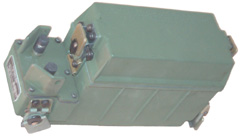 It has
two push type terminals for Radio Wire Integration. So a
single pair is all that's needed for remote operation. The
C-11561 Remote Control Unit (RCU) looks almost identical to the
RT-1539 SINCGARS radio and allows almost full control of all
radio functions using just one pair or normal field wire.
Note that the CY-8523 battery box is used on both the radio and
the RCU and the telephone binding posts are used to interconnect
both units.
It has
two push type terminals for Radio Wire Integration. So a
single pair is all that's needed for remote operation. The
C-11561 Remote Control Unit (RCU) looks almost identical to the
RT-1539 SINCGARS radio and allows almost full control of all
radio functions using just one pair or normal field wire.
Note that the CY-8523 battery box is used on both the radio and
the RCU and the telephone binding posts are used to interconnect
both units.
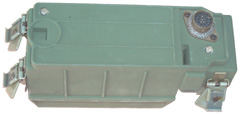 J1 is the connector that mates
to the radio. It has 27 socket positions, but only 5
sockets are installed.
J1 is the connector that mates
to the radio. It has 27 socket positions, but only 5
sockets are installed.
Battery 4 (Aside+) through diode to J1-F
Battery 5 (Bside+) through diode to J1-F
Batttery 1 (Aside-) to J1-U
Battery 2 ((Bside-) to J1-U
Battery 3 to J1-Z
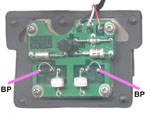 The 2 Binding Posts go through surge
suppression circuitry and a transformer before getting to J1
pins a & Y.
The 2 Binding Posts go through surge
suppression circuitry and a transformer before getting to J1
pins a & Y.
The two battery sections are wired in parallel (each through a
series diode) for 15 Volts output. The Yellow wire is
connected to battery terminal 3 which is tied to terminal 1
(negative) when the battery is a rechargable type, see table above.
This would allow charging rechargable battery types and NOT
charging primary batteries.
J1
|
Wire Color
|
Function
|
A
side
Battery
|
B
side Battery
|
Battery
3
|
F
|
Orange
|
+15 V
|
4+diode
|
5+diode
|
|
U
|
Yellow
|
Gnd
|
1
|
2
|
|
a
|
White
|
Audio Remote
|
|
|
|
Y
|
Red
|
Audio Remote
|
|
|
|
Z
|
Black
|
Rechargable gnd check
|
|
|
Recharg-
able
|
CY-7875/PRC-104
See the
PRC-104
web page for more on this battery box that holds 2 each BA-5590 or
BB-590 batteries and has a built in charger that runs from a
vehicle "24 Volt" electrical system.
LST-5
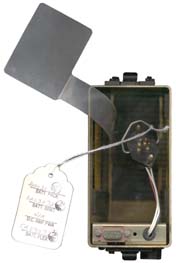
This box holds a single BA-5590 family
battery. The box is just slightly larger than the battery
and so has a flexible plastic bail with a large tab on the top
that can be used to pull the battery up out of the box enough to
get a hand hold on the battery itself. The plug that goes
into the battery is a custom made unit that's fairly thin and it
too had a bail for unplugging. The connection between the
battery box and the radio is by means of a DB-9(f) socket in the
battery box.
The plug has no keys to force how it is installed but because of
the angles between the 5 battery socket pins the plug can only
be installed one way.
Battery pins 2 and 4 connect to white wires that from a jumper
so that the black wire going to pin 1 is the negative lead and
red wire going to pin 5 is the "24 Volt" (30 volts for a fresh
BA-5590) lead.

There's a surface mount LM211 voltage comparator a few
diodes, 2 larger parts marked Q1 and Q3 and a TO-220 package
marked Q2. This may be a combination of a voltage
regulator and a battery disconnect circuit.
Q1 = Q3 = 340 T2 955E
Q2 = MT P5, ONO5E, 337
U1 = 37AD, LM, 211M
The circuit acts like a relay and connects power to the radio
when a jumper is connected between pins 1 and 6.
Pin
|
Function
|
1, 3,
7
|
+ Out
|
5, 9
|
Switched
- Out
|
6
|
open
= off
to +Out = On
|
The battery is connected in series so the output is 20 to 30 VDC
Lithium Chemistries used for batteries
Many people say "Lithium" battery and then go on to talk
about specifics that only apply to one of the following battery
chemistries, but most likely not to all of them. There are
primary and rechargeable Lithium chemistries and chemistries that
provide anywhere from 1.5 to 3.7 Volts per cell.
- Lithium/Sulphur Dioxide (Li/SO2) - 3 Volts/cell -
common military chemistry and used in the BA-5590/U
- Lithium Manganese Dioxide (LiMNO2) - 3 Volts/cell
- common 123
photo battery and many others like the CR2
- Lithium Ferric Sulfide (LiFeS2) -1.5 Volts/cell
- Eveready
LS91 - Radio
Shack 23-663 - 1.5 Volt/cell
- Lithium/Vanadium Pentoxide (Li/V2O5)
- Lithium/Oxyhalides (SOCI2 and SO2CI2)
- Lithium/Lithium Cobalt Dioxide (Li/LixCoO2)
- Lithium Thionyl Chloride (Li-SOCl2 - Jelly Roll) -
3.6 Volts/cell
- Lithium Ion - popular battery for laptop computers. 3.7 V/cell
Maybe the highest energy per unit volume
- Lithium Polymer is used now for RC airplanes and helicopters
since it offers the highest energy per pound. Some
restrictions on charge or discharge voltage and current. 3.7
Volts per cell. Capable of supplying extremely high
currents, more than other battery types. Maybe the highest
energy per unit weight.
Where Used
STAR
1175C REMBASS Unattended Ground Sensor Repeater Relay
(RT-1175/A or RT-1175/B)
GSQ-137 REMBASS
RT-1402A/G 226 to 400 MHz AN/PSC-3 radio
URC-200 VHF/UHF radio
Advanced
Lightweight Microclimate Cooling System (ALMCS)
PRC-113
Javelin
anti tank - there are problems when the BB-2590 is used in the
Javelin system since it was designed
to use the BA-5590 which can not deliver high surrents.
PRC-117
KY-99
AN/PLQ-7
Manpac -
Modular
Advance Reconnaissance System (MARS) - MARS
-
AN/PPS-15DS, AN/PPS-5 GS ground survalence radars
EPLRS
UHF Radio Set AN/VSQ-2(V)2 -
ASELSAN - 4300 Have-Quick I and II (slow), SATURN (fast) frequency
hopping ECCM radio
Scope
Shield II Communications System
Night Vision Equipment Company - broadband
thermal marker -
AN/GSQ-187
AN/PDR-75
AN/PPN-19
AN/PRC-104 - 3.5A @ 24V Tx, 0.2 A @ 24V
Rx TM 11-5820-919-12, -40-1, -40-2, -10HR
AN/PRC-113
AN/PRC-117
AN/PRC-119 SINCGARS TM
115820-890-10-1, -10-8, -12, SB 11-131-2 - RT-1439,
RT-1523
AN/PRC-132
AN/PSC-3
AN/PSQ-4
AN/TAS-4A
AN/TAS-6A
AN/UIH-6
AN/UIH-6A
AN/URC-100, -104 TM
11-5895-1195-10, -10HR
AN/VRC-100
AN/VER-101
AN/VRC-110
C-10377/GRC
Compact Laser
MST-4A
LST-5B
MAFIS
MX9331
OD-144/GYK-29
OE-239
PM-15
PM-15A
RT-1175/GSQ
TSEC/HYX-57
TSEC/KY-57
TSEC/KY-67
See Appendix A of the Battery
Safety Guide for more.
BA-5590 Style Connectors
Battery Sockets
One of the first Dead Lines on the
BA-5590 was due to a manufacturer not floating the socket.
When a battery rotates inside the battery box large forces can be
placed on the mating plug pins, even breaking them. Note
that some battery boxes use a cable to connect to the battery thus
avoiding any problem caused by a non floating socket.
Note the BA-5590 does not have any
extra
top contacts.
 Primary
Primary
The BA-5590 shown at the top has an all plastic socket. As
shown the wide key is pointing up above pin 1.
There are 4 narrow keys at 4,5, 7 & 8 o'clock.
Mathews Associates;
Connector
Corporation -
Pin 3 is not connected in primary batteries.
Not gold plated contacts, intended for single use.
Secondary
The BB-590 shown at the bottom has a plastic insert with a wide
key pointing up above pin 1.
There are 3 narrow keys at 4, 7 & 8 o'clock.
The outer part of the socket where the locating pins ride is
metal, unlike the all plastic primary socket.
Pin 3 is connected to pin 1 and pin 3 is used as the negative
terminal on many devices that charge this family of batteries,
that way the charger will not try to charge a primary
battery. But I've heard that many other charging devices
only depend on the key at 5 o'clock to prevent a primary battery
from being installed in a charger. Gold plated contacts for
multiple insertions.
Supply
Net - has a good selection of 5590 plugs and sockets.
Equipment Plugs
BAI Aerosystems
-
"106" plug - for BA-5590 The plug is available with a shell
for use on a cable and with a flange with mounting holes for panel
mounting.
Van Brakel
Electronics - has plug CA110821-6 for the BA-5590 - this is
the connector with 2 locating pins that's found on many radios.
Fair Radio has
some metal plates with a plug attached
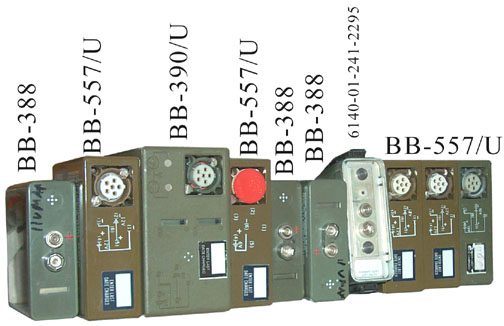
The above batteries are sitting on a shelf. This allows
seeing the relative size.
BB-388 6140-01-419-8190
BB-390A/U and BB-388/U are Nickel Metal Hydride (NiMH)
6140-01-419-8187
BB-503A/U are Nickel Cadmium (NiCAD) 6140-01-419-8193
BB-516A/U are Nickel Cadmium (NiCAD) 6140-01-419-8191
BB-2800/U - PLGR, BA-5800 replacement
BB-2847/U battery is a Lithium-ion (LiION) 6140-01-419-8194
Unknown 5590 size battery adapter
What batteries go into this and what does it do?
It is very light, i.e. I think there's no electronics inside.
There are three battery compartments:
2 deep ones that seem to hold 2 AA batteries in each, for a total
if 4 series connected cells (6 Volts).
1 shallow compartment too short for a AA cell, and although a
CR123 will fit it bows the lid so probably some other cell (N?).
Note only the connector sockets for the two internal batteries 2 -
3 & 1 - 4) are populated with socket pins.
Buzzing out the wiring shows socket pins 1 & 2 connected (-)
and pins 4 & 5 connected (+) so it's a single 12 volt battery.
An "N" cell is too small in diameter for the single battery
compartment. (This is for a CR123 or BA-5123/U battery)
A CR123 is too big in diameter for the 2 deep battery
compartments. (they are for AA cells)
Shown below next to a real BA-5590. If you know what this
please let me know.
Answer from Dean M. referring to the American
Mil-spec web page:
"Unicor Military Radio Battery Assembly for PRC-117G or PRC-150
modern radios Hold-up battery 6160-01-492-5650 A3272554-2,
This assembly is the exact same size as a standard BB-390,
BB-5590, etc. battery. It is empty inside and holds qty 4 AA
batteries and 1 CR-123A lithium battery. This is meant to be a
hold-up battery for when the radio is used in a vehicle setting.
These could be easily taken apart and made into other types of
battery adapters."

Links
NRL
Charges Marine Corps Expeditionary Power Requirements -
Solar panel, charge controller, BB-2590/U
Technologies
that make a difference - "An official Department of State
position sites that Columbia and Afghanistan provide the clearest
examples of the growing convergence among drug trafficking,
terrorism, and organized crime."
BAI Aerosystems
- "106"
connector - for BA-5590
Marines
capitalize
by saving the Corps millions -
Battery
Eliminator -
Belss
- analyzer, eliminators
Iris - battery
eliminator
SINCGARS Alternative
Power Supply Suitcase model (ASAPS-SC) -
CA NG - Ground
Precautionary - # 97-007 CECOM GPM #97-007 All equip
utilizing 2 or more BA-5590/U Lithium Sulfer Dioxide Battery.
Berg Battery Tester - BT-1
pocket tester
CBD - Market
Survey for Battery State Of Charge Meter -
CBD - Battery System SOL M00681-99-Q-M11104 DUE 04/06/99 - for
BA-5590 without fuel guage
Applied Design Concepts - adapter cagble to allow use of BA-5590
type batteries for STE/STU III/KIV-7
Defense
Update Feb 2004 - Many Battery Articles (a few minor typos)
Fact
Sheets and Information Papers Lithium Sulfur Dioxide Batteries
- venting problems
final
report describing the Ft. Hood Battery Mgmt. Task Force -
Ft Hood - Appendix
H State-Of-Charge (SOC) Meters for Lithium Batteries -
TS-4403A/U -- CTA item ($4905) BA-5590, BA-5598, and BA-5588
Lind Electronics - some cables
that mate to the BA-5590 family batteries
Simpower Limited
- battery dealer
Medtronic
Physio-Control - info on their LiSO2 battery - Background
on Lithium Batteries -
Moby Power
-
Rejo - Rechargable
Batteries - Primary
Batteries -
www.hdssystems.com (go to
"products", then "lithium battery")
http://www.dtic.mil/natibo/docs/
(then select "joint battery
industrial sector study - executive summary")
Information
about Non-rechargeable Lithium Batteries (this PDF file
requires Adobe Acrobat Reader)
S.C.Levy and P. Bro, Quality and Reliability Methods for Primary
Batteries, Wiley, New York, 1990 (ISBN 0-471-52427-1)
S.C.Levy and P. Bro, Battery Hazards and Accident Prevention,
Plenum, New York, 1994 (ISBN 0-306-44758-4)
HDS Systems -miners head
lamp - Lithium/Sulfur Dioxide Battery - Saft LO26SX 3
V "D" cell.
AnIdea.com - Battery
Tester - US Patent 4659994 - only for detecting reversed
cell, not SOC
TI - bq2052 gas
guage to build into a LiSO2 battery -
Document ID: MIL-B-49430/3G
NOT
2 -
CECOM
Logistics
& Readiness Center - Acquisition
Reform Homepage - MTS
Good Examples - Battery
Standardization -
Preferred Power Sources
Primary: BA-5590B, BA-5588A,
BA-5567A, BA-5347, BA-5372, BA-5800A, Commercial: AA, AAA, C, D,
9V
Rechargeable: BB-390A, BB-388,
BB-516A, BB-503, BB-2847
Linear Technology - LTC2400
24 bit ADC on a chip
Van Brakel
Electronics - may have a plug for the BA-5590
House of Batteries
- carries Saft and many other batteries
War Fighter
Solutions - Technical
Hacking For Military Equipment - How to make BA-5590 adapter
cables
YouTube: Why do Li-ion Batteries
die ? and how to improve the situation? by Jeff Dahn
Back to Brooke's Battery,
Military Information, Home page
Page created 31 Dec 2001.













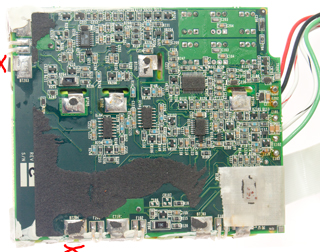

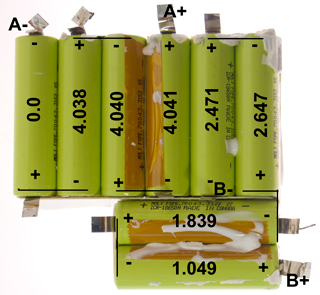





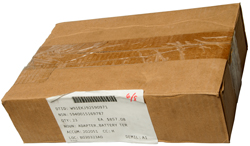

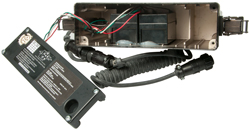
 It has
two push type terminals for Radio Wire Integration. So a
single pair is all that's needed for remote operation. The
C-11561 Remote Control Unit (RCU) looks almost identical to the
RT-1539 SINCGARS radio and allows almost full control of all
radio functions using just one pair or normal field wire.
Note that the CY-8523 battery box is used on both the radio and
the RCU and the telephone binding posts are used to interconnect
both units.
It has
two push type terminals for Radio Wire Integration. So a
single pair is all that's needed for remote operation. The
C-11561 Remote Control Unit (RCU) looks almost identical to the
RT-1539 SINCGARS radio and allows almost full control of all
radio functions using just one pair or normal field wire.
Note that the CY-8523 battery box is used on both the radio and
the RCU and the telephone binding posts are used to interconnect
both units. J1 is the connector that mates
to the radio. It has 27 socket positions, but only 5
sockets are installed.
J1 is the connector that mates
to the radio. It has 27 socket positions, but only 5
sockets are installed.  The 2 Binding Posts go through surge
suppression circuitry and a transformer before getting to J1
pins a & Y.
The 2 Binding Posts go through surge
suppression circuitry and a transformer before getting to J1
pins a & Y.



